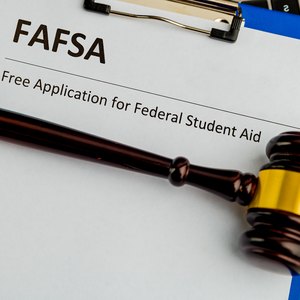
The cost of a college education is on the rise, with students paying more than $11,000 a year in 2022 for in-state tuition. Federal financial aid can reduce that cost substantially. To qualify for federal financial assistance, you’ll have to complete the Free Application for Federal Student Aid, which will help connect you with grants, work-study opportunities and low-interest loans from the federal government.
What Is the FAFSA?
The FAFSA is an application college students complete to qualify for financial aid. You’ll need to go through the process each year to get financial assistance from the government. Funds are issued on a first-come, first-served basis, and you can apply as early as October 1 for the next school year. You'll need to list your target colleges on your FAFSA application.
Although there are loans and scholarships available outside FAFSA, most student assistance comes from federal and local government sources. Those funds are only available by completing the FAFSA, so it’s worth taking the time to do it each year. Applying automatically qualifies you for a low-interest loan, and some merit-based scholarships will require you to complete the FAFSA to determine how much help to give you.
How to Submit the FAFSA
Applying for aid from the federal government is free, quick and easy. You’ll either go to FAFSA.gov or use the myStudentAid app, which is available on both iTunes and Google Play. You can also complete a printable form and mail it via the postal service, but you won’t get the step-by-step assistance that comes when you use the app or website.
After you’ve submitted your application, you’ll receive a Student Aid Report that confirms your submission and estimates your eligibility. You can check the status of your submission at FAFSA.gov. It usually takes three to five days to process an online application or seven to 10 days to process a paper form.
To qualify for federal financial assistance, you’ll have to complete the Free Application for Federal Student Aid, which will help connect you with grants, work-study opportunities and low-interest loans from the federal government.
Reviewing Your Financial Aid Offers
Once your application has been processed, you’ll receive a financial aid offer. This will tell you how much aid you’ll get at each school you listed on your application. If you’ve applied to multiple schools, you’ll be in the enviable position of comparing offers and choosing the one that’s best for your educational and financial needs.
Building your financial aid package means choosing which aid to accept. To keep your costs as low as possible, accept all free money first, then choose any work-study opportunities issued. Federal student loans should come only after you’ve accepted all free financial aid, and go for the lowest interest rate possible.
Other Financial Aid Opportunities
Once you’ve set up your federal and state financial aid, it’s time to look into other types of financial aid that are available. Your high school guidance counselor can help with this, or you can go through one of the many college scholarship databases that are available. Your state might also have assistance opportunities. In many states, you can even attend free community college.
Federal student loans aren’t the only option available. There are also private student loans that offer competitive interest rates. Federal student loans will typically feature lower rates, but it’s worth comparing. These private loans can help take care of any expenses your government aid doesn’t cover.
Although a college education is more expensive than ever, it’s also easier than ever to get financial assistance. You can apply online in just a few steps and look for ways to supplement that assistance with private personal loans. Choosing an in-state school or taking advantage of free community college options in your area can also help reduce the overall cost of getting an education.
References
- U.S. Department of Education: What Is the FAFSA?
- U.S. Department of Education: List at Least One College From Your School List While Completing the FAFSA® Form
- U.S. Department of Education: Complete the FAFSA® Form
- U.S. Department of Education: 2022–23 Free Application for Federal Student Aid (FAFSA®) Form and the FAFSA on the Web Worksheet (EA ID: APP-21-15)
- U.S. Department of Education: SAR: Student Aid Report
- U.S. Department of Education: Comparing School Financial Aid Offers
- U.S. Department of Education: Accepting Financial Aid
Writer Bio
Stephanie Faris has written about finance for entrepreneurs and marketing firms since 2013. She spent nearly a year as a ghostwriter for a credit card processing service and has ghostwritten about finance for numerous marketing firms and entrepreneurs. Her work has appeared on The Motley Fool, MoneyGeek, Ecommerce Insiders, GoBankingRates, and ThriveBy30.
